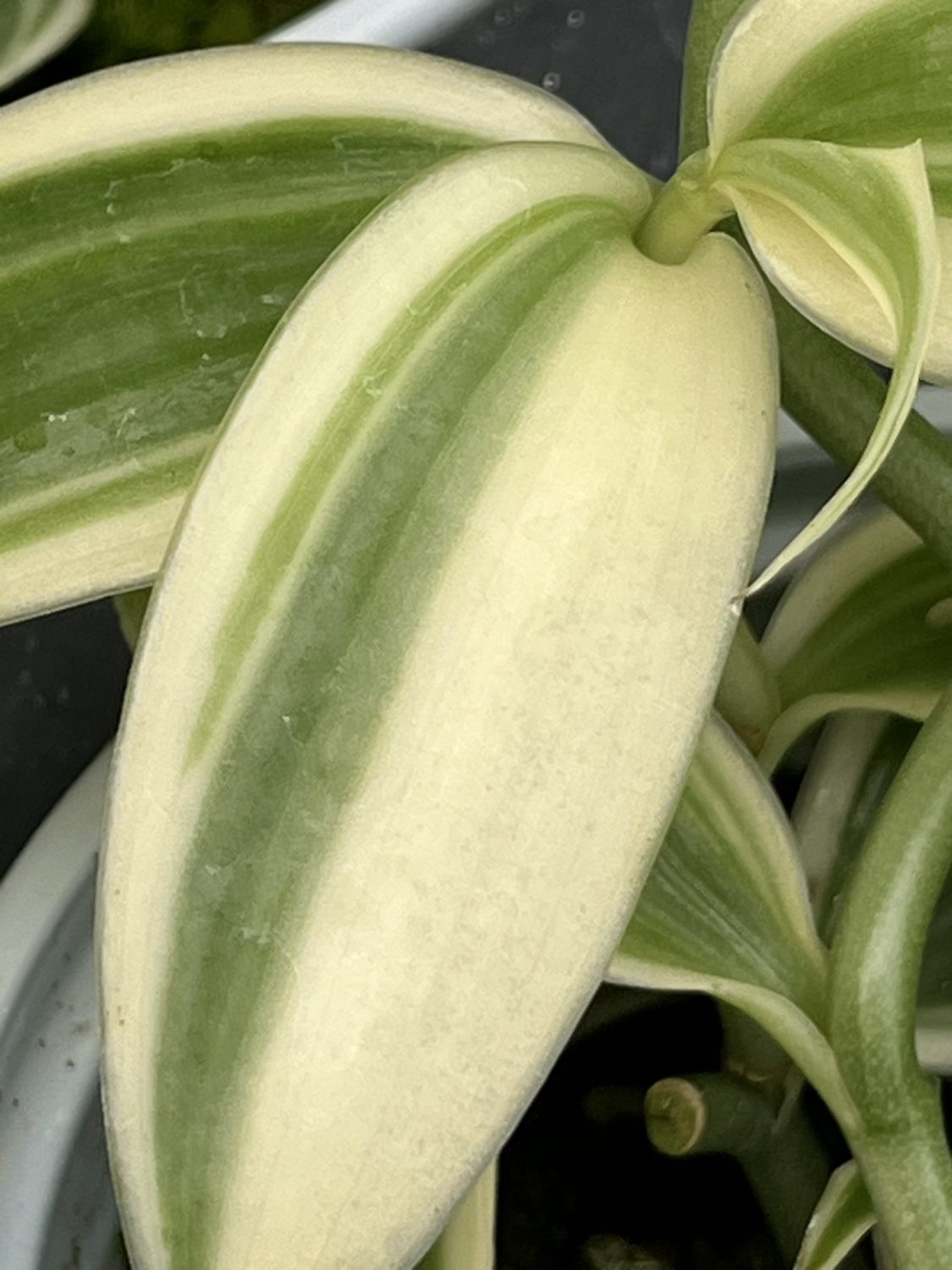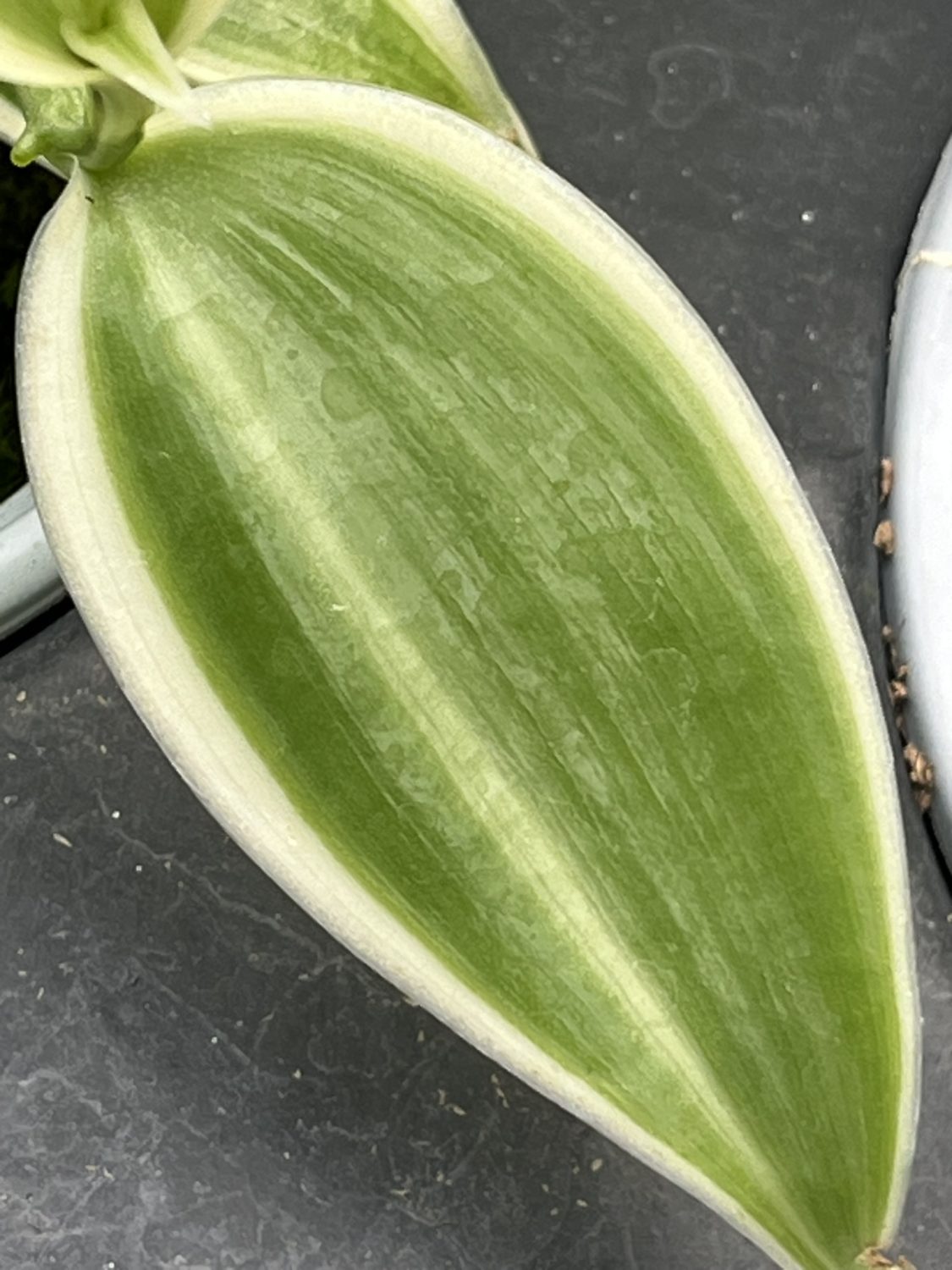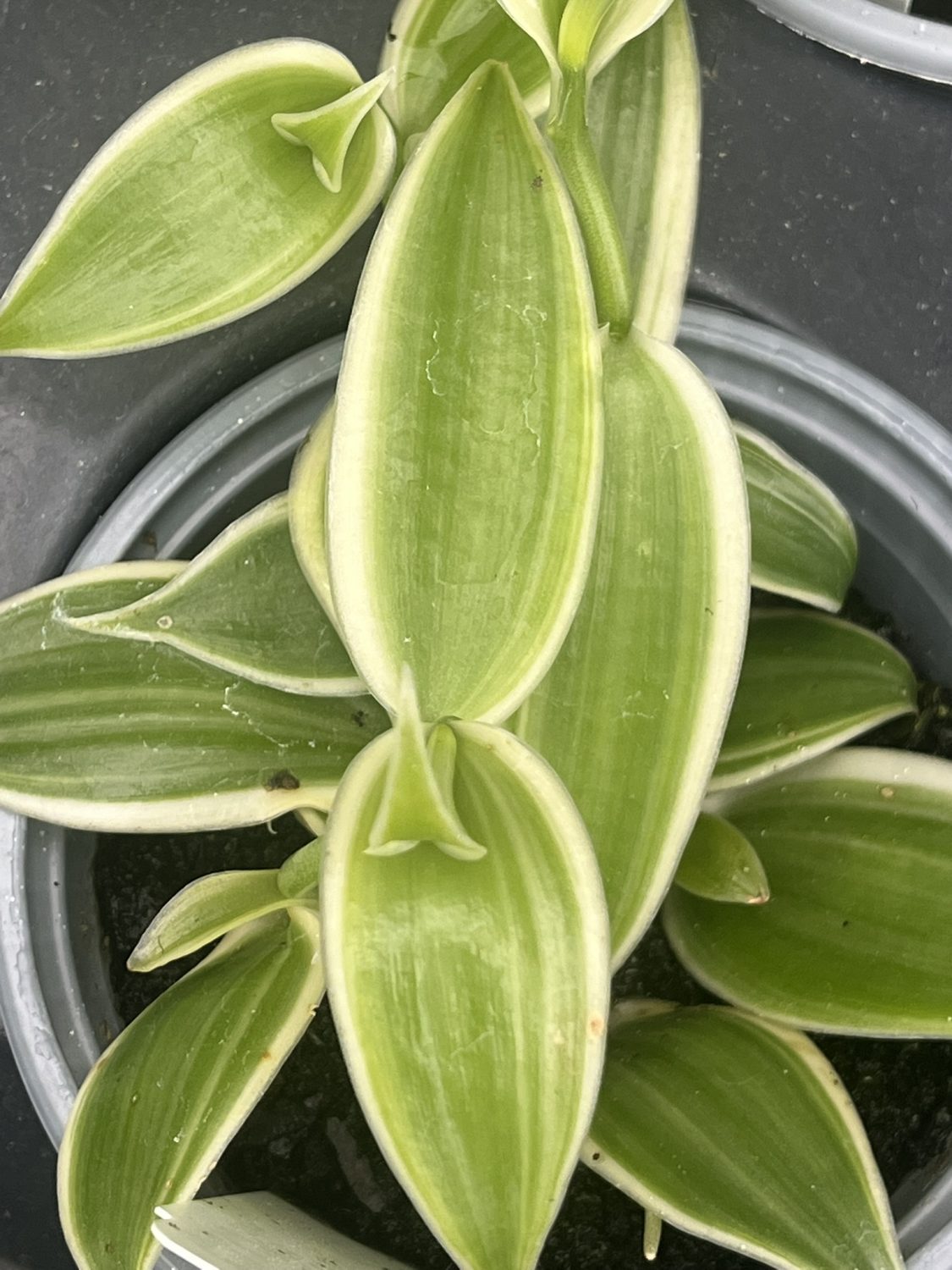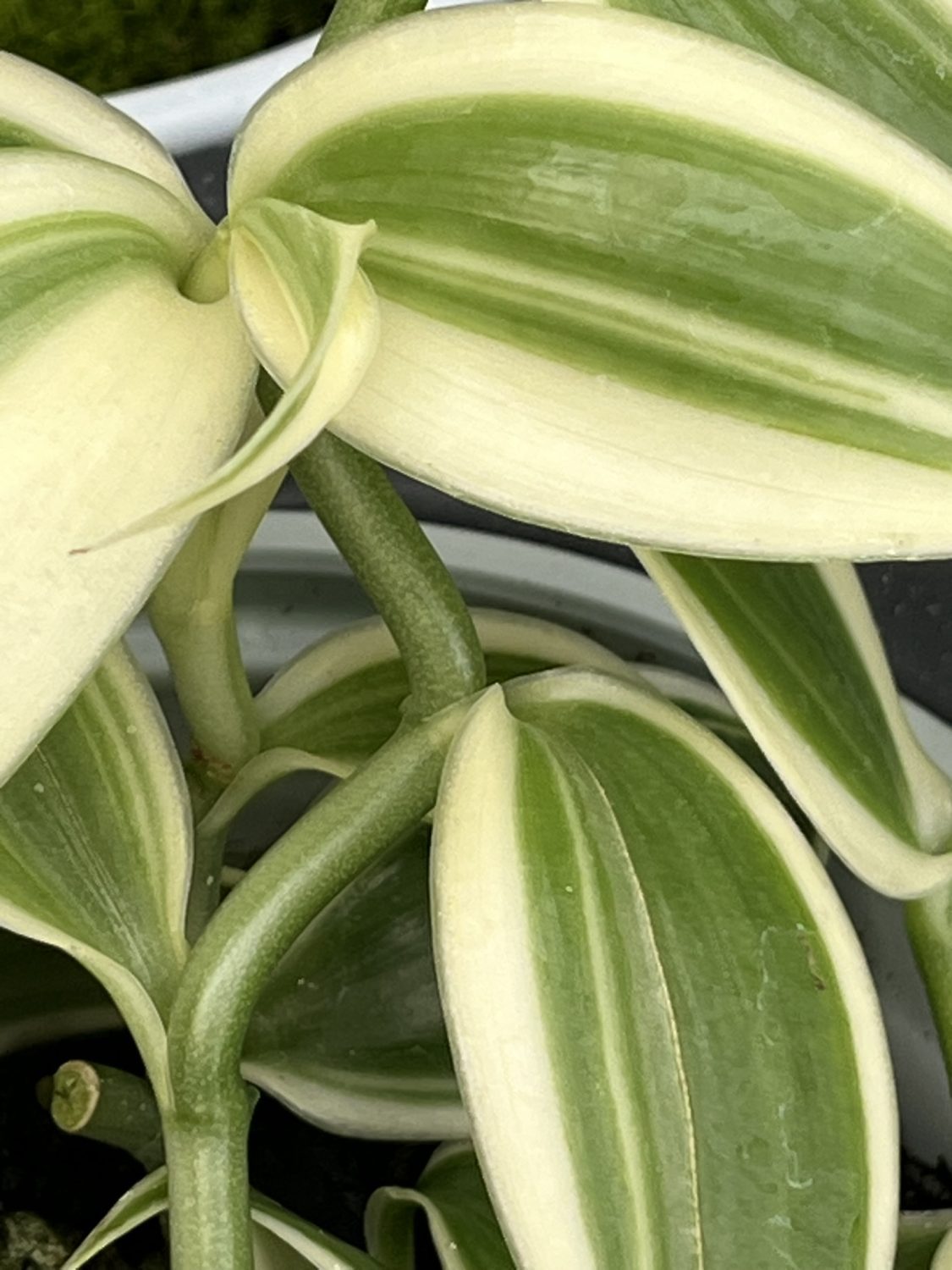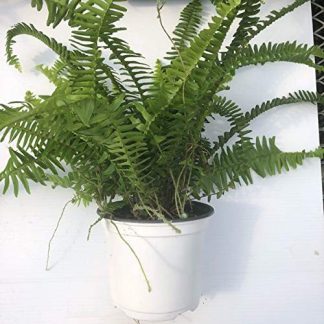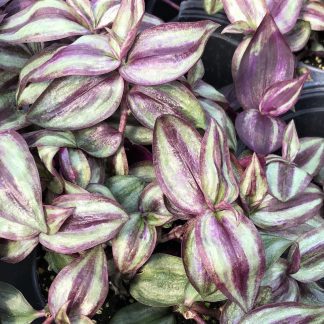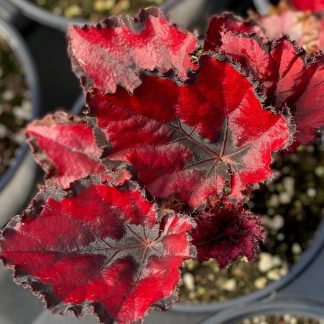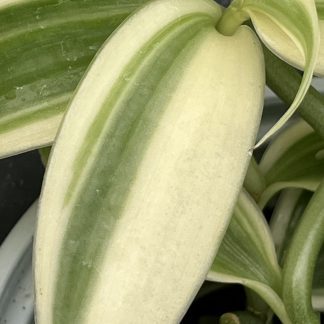Description
Vanilla planifolia ‘Albo-Variegata’ — The Cream-and-Green Vanilla Orchid
Meet Vanilla planifolia ‘Albo-Variegata’. It is the classic vanilla vine with bright white streaks that glow. The leaves look painted. The stems climb and curl. The whole plant feels calm and tropical. In other words, you get beauty and a true kitchen story in one living piece.
We’ll walk you through care, style, and simple steps to try for pods one day. We’ll keep it friendly and clear. Short tips. Easy routines. Confident results. That way, you can enjoy your striped vanilla from day one.
Why We Love This Striped Vanilla
Bold foliage with natural drama. Each leaf carries creamy white variegation over deep green. The pattern shifts from leaf to leaf. No two vines look the same. Sunlight makes the white shine.
Real vanilla heritage. This is not just pretty. It is the plant behind vanilla beans. With time and hand pollination, you can grow real pods. That is special.
Upright habit with a small footprint. The vine climbs a pole or trellis. Instead of spreading wide, it goes up. This saves space and adds a clean, vertical line.
Forgiving to learn on. Steady light. Gentle water. Warm air. That’s the playbook. After more than a few weeks, you will see firm, glossy leaves and fresh roots reaching for the pole.
Plant Profile at a Glance
- Botanical name: Vanilla planifolia ‘Albo-Variegata’
- Common name: Variegated Vanilla Bean Orchid
- Type: Evergreen, climbing orchid
- Foliage: Green leaves with white to cream variegation
- Light: Bright, indirect; soft morning sun is welcome
- Water: Even moisture with full drainage
- Humidity: Medium to high (50–70% is ideal)
- Temperature: 65–85°F for best growth
- Support: Needs a pole, trellis, or mount
- Mature size: Vines can reach many feet with training
- Uses: Showpiece foliage; potential vanilla pods on mature vines
Light: Bright and Gentle Wins
Give your plant bright, indirect light. East windows are great. Soft morning sun builds color and strength. Harsh midday rays can bleach the white parts first. Use a sheer curtain in south or west windows.
Signals to watch:
- Too little light: Long gaps between leaves and dull color.
- Too much light: Pale patches or crisp tips on the white areas.
Turn the pot a quarter turn each week. This keeps the vine straight and the leaves even. In other words, share the light around.
Water: Soak, Drain, and Breathe
Aim for even moisture. Water when the top inch of the mix feels dry. Soak the pot until water runs from the bottom. Let it drain fully. The roots want air between drinks. This rhythm is simple and strong.
Avoid extremes:
- Never soggy. Roots need oxygen.
- Never bone-dry. Leaves may curl and slow down.
You can mist the aerial roots on the pole. This helps them grip. It also boosts local humidity where it counts.
Humidity and Temperature: Warm Rainforest Vibes
Hold temps in the 65–85°F range. Keep humidity near 50–70%. A small room humidifier helps in winter. Grouping plants also raises the local level. If leaf tips brown or aerial roots stall, nudge humidity up and review your watering pace.
Potting Mix: Chunky, Airy, and Light
This orchid likes air around the roots. Use a loose blend that drains fast and holds gentle moisture:
- 1 part medium orchid bark
- 1 part coco chips or coarse perlite
- 1 part high-quality potting mix
- A handful of long-fiber sphagnum blended in
Do not pack the mix tight. Keep it fluffy. Instead of squeezing it down, settle it lightly. Air pockets protect roots and help new growth.
The Support System: Give It Something to Hug
Support is not optional. It is the secret to big leaves and a neat shape. Choose a moss pole, wooden trellis, or cork slab. Tie the vine loosely with soft plant tape. As each node touches the support, aerial roots reach out and grip.
Tip: Keep the pole lightly moist where roots touch. This encourages quick attachment and faster growth.
Feeding: Gentle and Consistent
Feed during active growth with a balanced, gentle fertilizer at half strength every 2–4 weeks. Ease up in fall and winter unless you use bright grow lights. You want calm, steady growth. No heavy salts. Leaves should feel firm, and the white variegation should stay crisp.
Repotting: When to Refresh
Repot every 12–24 months or when the mix breaks down. Signs it is time: the pot stays wet longer than before, roots circle hard against the sides, or the vine needs a taller pole. Move up one pot size, refresh the mix, and secure the vine to the new support. Water well and let it settle.
Blooming: Patience Makes Magic
Variegated vanilla blooms on mature vines. It takes time and good training. You will often see flower spikes from older sections of the vine. The blooms are soft, elegant, and short-lived—often open for a single day.
Watch mornings when buds are near opening. That is your window. Be ready if you plan to hand pollinate.
Hand Pollination: Simple Steps to Try for Pods
You can make pods at home. Most of us do it by hand. Here is the friendly guide many growers use:
- Check early morning. That is when the flower is most receptive.
- Lift the flap. Inside is a thin membrane (the rostellum) between the pollen and the stigma.
- Move the pollen. Use a toothpick or fingertip to press the anther onto the sticky stigma.
- Hold gently for a second. Make clean contact.
- Stay calm. One neat move is better than many pokes.
If it works, a long green pod will start to swell behind the flower. Maturation takes months. Keep care steady. Keep the vine warm and supported. After more than a season, you may be ready to cure pods for fragrance and flavor.
Propagation: Easy Node Cuttings
Propagation is kind. Take a 2–3 node cutting from a healthy section. Let the cut end dry for a day. Lay the nodes against a moist moss pole or nestle them into your airy mix at the base of a support. Keep warm and a bit humid. New roots form first. A fresh shoot follows.
Troubleshooting Made Simple
- Leaves yellowing: Often too much water or too little light. Improve drainage and brighten the spot.
- Brown tips: Dry air or irregular watering. Raise humidity and steady your schedule.
- Variegation fading: Not enough light. Move closer to bright, indirect light.
- Slow growth: Cool temps, compacted mix, or low feed. Warm it up, fluff the mix, and feed lightly.
- Pests (mealybugs, scale): Wipe leaves with a damp cloth. Treat early and repeat weekly until clear. Keep nodes and leaf bases clean.
In other words, focus on light, water, air, and warmth. Fix those, and the vine responds.
Styling Ideas You’ll Enjoy
The statement pole. One tall moss pole with a single striped vine. Clean. Modern. Lush.
The looped hoop. Coil the vine around a hoop for a living wreath. Great for shelves and narrow spaces.
The trellis panel. Train two or three vines on a slim trellis. You get a soft plant “screen” behind a chair or entry table.
The kitchen story. Set near a bright east window. Add a small tag that says “This is the vanilla in your vanilla.” Guests will ask. You will grin.
Indoor or Outdoor?
If you live in a tropical climate, this plant can grow outdoors in bright shade. Protect it from hot, direct midday sun, which can scorch variegation. For most of us, indoors is best. A sunroom, a bright east window, or quality grow lights work very well. In summer, you can move it outside to a shaded patio. Bring it back in before nights drop below the mid-60s°F.
Safety Notes for Home and Pets
Vanilla orchids are generally considered non-toxic to people and pets. Still, keep all plants out of reach of curious nibblers. The leaves are too special to chew, and you protect your plant’s shape.
What You’ll Receive
You’ll receive a healthy, actively growing Vanilla planifolia ‘Albo-Variegata’ with fresh roots and bright, creamy streaks. Variegation patterns vary from plant to plant. That is part of the charm. Give it a support right away so the vine can climb and settle in fast.
Care Snapshot (Pin Near the Pot)
- Light: Bright, indirect; soft morning sun is ideal
- Water: When the top inch is dry; soak, drain, and let it breathe
- Humidity: 50–70% preferred
- Temp: 65–85°F
- Mix: Bark + coco/perlite + potting mix + a touch of sphagnum
- Support: Moss pole, trellis, or cork mount
- Feed: Half-strength, every 2–4 weeks in active growth
- Bloom/Pods: Hand pollinate morning flowers on mature vines
Who This Plant Fits Best
- The collector who loves rare, striped foliage.
- The home chef who dreams of growing real vanilla pods.
- The stylist who wants a tall, clean look with a tropical twist.
- The beginner who wants a forgiving plant with a clear routine.
Instead of choosing between pretty and purposeful, you get both in one vine.
Cream-and-Green Encore
Vanilla planifolia ‘Albo-Variegata’ brings bright stripes, calm growth, and a true vanilla story. With light that is kind, water that is steady, and a pole to climb, it rewards us again and again. In other words, it turns daily care into a sweet ritual. Bring one home, give it a hug-worthy support, and enjoy the show.

